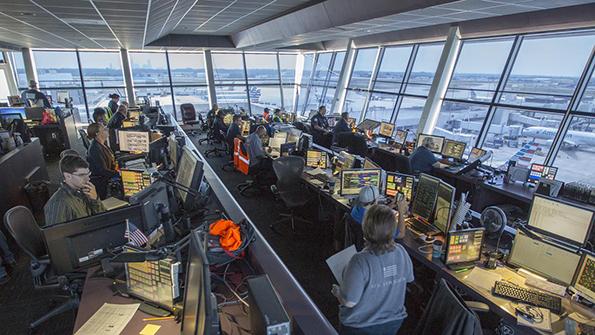
After more than five years of development, testing and refinement, an extension of the FAA’s primary airport surface management program designed to reduce airfield congestion has been deemed ready to deploy, with nearly 30 airports slated to receive the tool in the next decade.
Developed under the NASA-led Airspace Technology Demonstration 2 (ATD-2) program, the Integrated Arrival, Departure and Surface (IADS) system’s mission is straightforward—minimize taxiway congestion by calculating optimal aircraft departure timing.
- Airspace Technology Demonstration 2 delivers key software enhancement
- Tool expands Terminal Flight Data Manager’s capability
- Sources of actual and predicted data combine to create new scheduling program
“The software calculates when it’s best to have the airplane push back from the gate at busy hub airports, so that the airplanes can roll right to the runway,” FAA Administrator Steve Dickson said during a late-September event marking the system’s graduation from NASA-led development to FAA-directed deployment.
The IADS system sounds simple. But its development integrates data and functionality from multiple complex systems developed by both FAA and NASA that are building blocks of the Next-Generation Air Transportation System, or NextGen.
Chief among them is the Terminal Flight Data Manager (TFDM), NextGen’s surface management program that has been enhanced with the IADS system. The enhanced TFDM links with two other NextGen building blocks that, along with TFDM, form the NextGen Air Traffic Decision Support System—also known as “three Ts.” One of the two other branches of that triumvirate is Time-Based Flow Management (TBFM), used to meter capacity based on scheduled arrivals and other airspace system issues; the other is the broader Traffic Flow Management System (TFMS) that compiles and processes flight data, such as flight plans.

Two tools built by NASA for the FAA play key roles in the IADS system as well. The Spot and Runway Departure Advisor provides departure-metering advisories to controllers using trajectory-based surface predictions and scheduling algorithms. The Precision Departure Release Capability uses projected takeoff times and runway assignments to optimize departures and ascents so aircraft can efficiently merge into the en route traffic stream.
“With this capability we can reduce taxi delays and ramp congestion,” Dickson said. “After takeoff, the system enables air traffic controllers to merge your flight right into the stream of jet traffic,” he adds.
The IADS system relies on analyzing previously disparate, siloed datasets. Airlines provide 11 surface data elements to help the TFDM paint a picture of both desired and projected activity, including actual off-block, takeoff, landing and in-block times, as well as gate assignments and variances such as intent to de-ice prior to departure.
“TFDM requires an unprecedented degree of collaboration between air traffic control and airline flight operations,” said Shawn Engelland, NASA ATD project manager.

ATD-2’s development started in 2015. Testing began in 2017 at Charlotte Douglas International Airport with the participation of several operators—notably American Airlines, which uses the North Carolina airport as a hub.
“The key to the system that we demonstrated in Charlotte was this highly accurate surface-predictive engine that could look at arrival traffic and departure constraints—and information from the airlines regarding pushback plans and the predictions for when the flights will be leaving the gate—and put that all together in an integrated schedule,” Engelland said.
A subsequent trial phase, carried out at Dallas/Fort Worth International Airport and Dallas Love Field Airport in partnership with Southwest Airlines and American, linked the surface scheduling to terminal area airspace.
“There are airspace constraints in the [terminal environment] that impact the surface situation,” Engelland said.
The ultimate goal is a more predictable, efficient flow of aircraft from gates to cruising altitudes.
“The surface metering doesn’t change the delay,” he said. “It just shifts some of the wait time from the end of the runway to the gate, but that’s very important from an environmental savings point of view. The delay savings actually accrue when you’re inserting into the overhead stream [on more direct trajectories and finding] opportunities to look for earlier slots in the overhead stream.”
With testing and operational trials complete, plans call for the enhanced TFDM to be implemented at a total of 27 airports over the next 10 years, starting in 2022. Phoenix Sky Harbor International Airport is the next airport scheduled to receive the new software.
Once in place at all 27 airports, the system will save more than 7 million gal. of fuel and eliminate more than 75,000 tons of CO2 emissions annually, the FAA calculates.


Comments
Failure to release a gate being used by a departure that is needed for an arrival can create gridlock, especially at airports where some flights can only use certain gates due to aircraft type, customs, connections, etc.